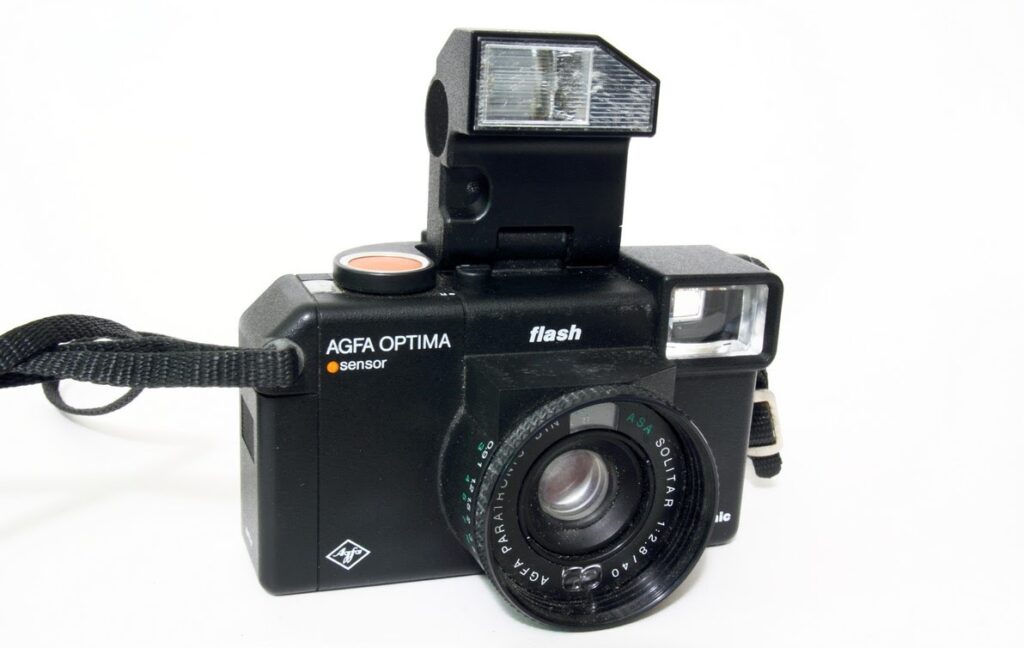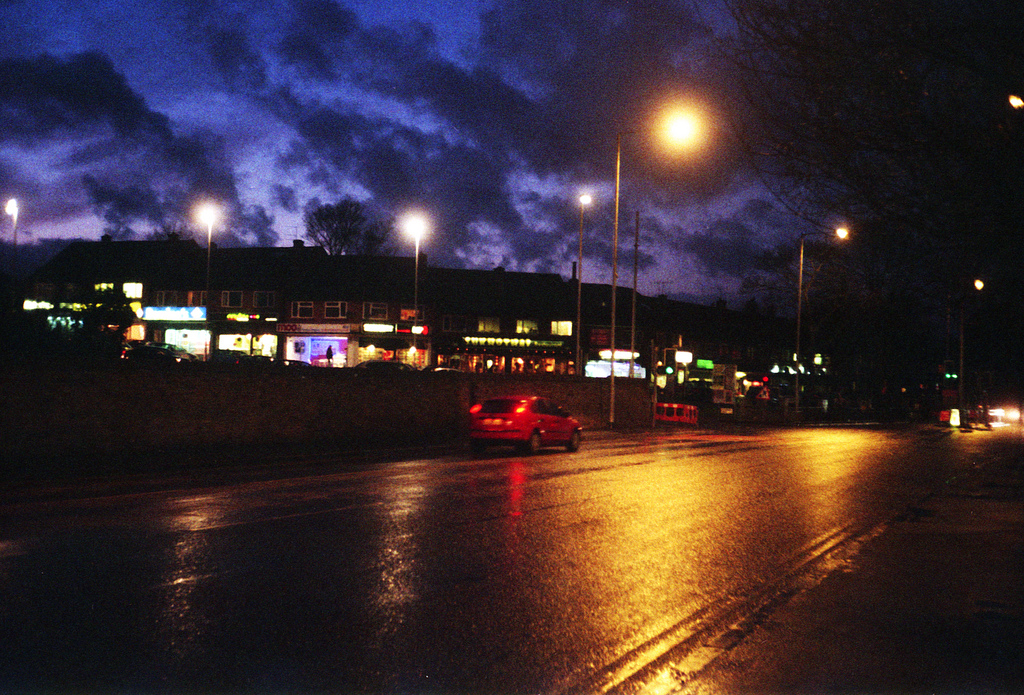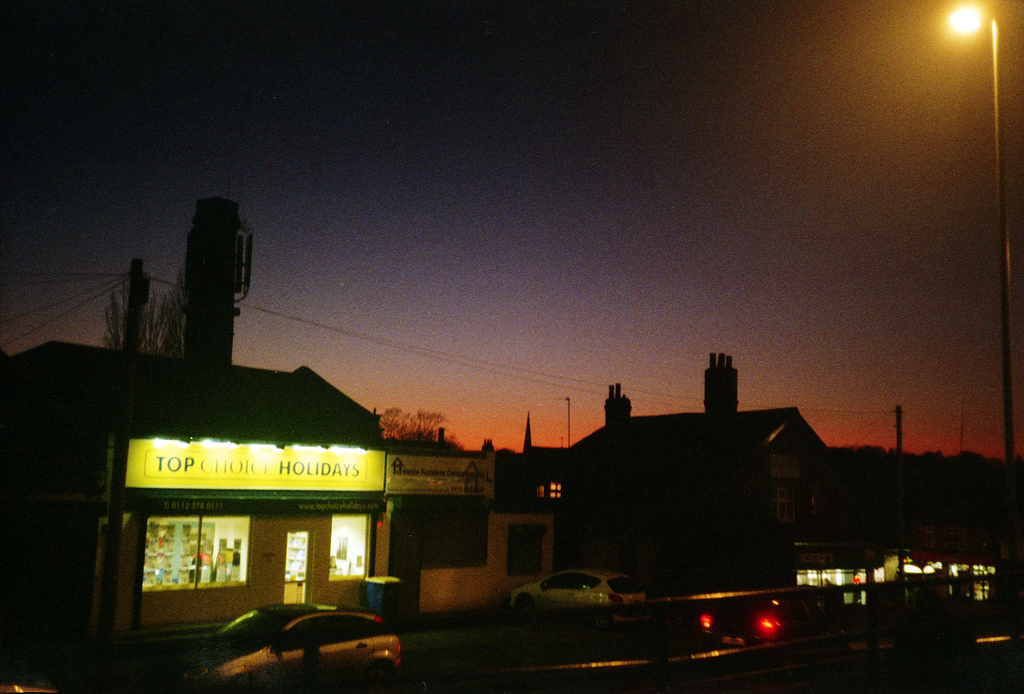Agfa Optima Flash Sensor
I found this quirky little camera in Oxfam for £5.99 for a copy in very good mechanical, optical and cosmetic condition, with case. There is a reasonable amount of literature on the internet about the Agfa Optima Sensor series, though much of this is in German. I am frequently seeing this camera described as a rangefinder, but the manual does not indicate this.

About
The Agfa Optima Flash Sensor was manufactured from 1981-1983; it is classic a 80s style, with a futuristic looking black coated metal and plastic body and an angular chunky design. It has the standard Agfa red membrane button for the shutter.
There are two particularly interesting features – the first being that to rewind the film you need to engage the rewind button and then continue using the film winder. The second is a plate that snaps down over the receiving reel, protecting exposed frames if the back is accidentally opened.
It has a fairly large, blocky, pop-up flash with a guide number of 12. I am not fully clear how engaging the flash affects the exposure program.
Lens and Focus
The lens is 40mm, and pretty sharp with its 4 elements in 3 groups. This gives a field of view of 48° x 33°, standing about 3m away will you allow for a full body portrait. The focusing is a continuous zone focus system, with guide indicator symbols for single person, groups and landscapes on one side of the lens barrel, and a distance scale on the other.
Exposure
The shutter is an electronically controlled 2 bladed leaf shutter. The exposure is shutter priority program AE – this means that both the shutter and aperture are set by the camera, favouring a faster shutter speed. It does not make sense to produce an exposure table for this reason, but some tips and tricks can be used.
ISO is set by a dial on the front of the lens barrel, also on the front here is the light sensor, which means you can attach a filter to the 49mm thread and meter as normal.
The longest exposure is 1/45s and the fastest aperture is f/2.8, at ISO 400 this gives an EV of between 6 (brightly lighted home interiors, amusement parks) and 7 (Brightly lighted night-time streets, stage shows). With the highest native ISO setting of 500 this is about EV 6, but you don’t tend to find ISO 500 film nowadays. You could use this is a well lit club without a flash, just. This camera does some nice stuff in low light.
With ISO 200 film you are looking at EV 8 (city centre squares, floodlit stadiums, brightly lit interiors with fluorescent lighting), with ISO 100 EV 9 (landscapes 10 minutes after sunset, spotlit subjects), with ISO 50 this is EV 10 (landscapes immediately after sunset), with ISO 25 this is EV 11 (sunset, subjects in deep shade).
I have read, though not confirmed through a validated source, that the minimum aperture is f/22 – This will handle any natural light you could throw at it.
Tips and tricks
Setting the ISO selector controls the meter. So in low light you could just use higher ISO rated film. From tests I think that it will just default to it’s best exposure if the light is too low, rather than refusing to take a shot, so you could use ISO 800 film to get a better exposure in these conditions. You would of course not be able to use this in situations where the lighting was brighter, as you would over expose one stop – but this is often fine on negative film.
Using the ISO selector gives you a limited level of exposure compensation – for example in a bright backlit subject you could decrease the ISO to fool a longer shutter speed and ensure the subject is better exposed. Similarly to avoid bleaching out a sky you could increase the ISO, forcing a faster shutter speed possibly creating a silhouette.
Gallery


Vital Statistics
Camera Type: 35mm full frame camera with EE aperture control, automatic mode (2 bladed leaf shutter).
Film Format : 135 Cartridge (24x36mm).
Lens: 40 mm f/2.8 Agfa Paratronic Solitar (4 elements, 3 groups).
Filter Size: 49 mm.
Focusing Range: 0.90m to infinity.
Shutter Speeds : 1/45 sec – 1/1000 sec.
Exposure meter: Single CdS cell located above front lens element.
Film Speed Range:ISO 25 (DIN 15) to ISO 500 (DIN 28).
Focusing System: Zone Focus.
Film Advance: Single-stroke, Built-in double exposure and double winding prevention.
Filter Thread: 49mm – filter covers metering cell, no adjustment needed.
Accessories: Wrist Strap.
Battery: Two 1.5 volt type AAA battery.
Flash: Pop-up, Guide no 12 at ISO 100.
Weight: 325 g.
Dimensions: 118 x 86 x 59mm.
Links
All my images on Flickr using the Optima Flash Sensor.
Agfa Optima Flickr Group.
Optima Flash Sensor on La Collection de Appareils (French).
Agfa Optima Family on Alfred’s Camera Page.
Optima Flash Sensor on Wikipedia.
Optima Flash Sensor on Christian Zhan’s Optiksammlung (German).
Optima Flash Sensor on Fotografien von Stefan Oldenburg (German).
Thanks for linking back. I think I will run some tests as the answer to your question from Stan suggests…